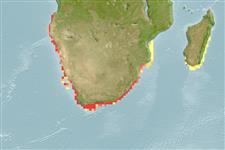Teleostei (teleosts) >
Eupercaria/misc (Various families in series Eupercaria) >
Sparidae (Porgies)
Etymology: Rhabdosargus: Greek, rhabdos = stick + Latin, sargus = sargus (1591) (Ref. 45335).
More on author: Valenciennes.
Environment: milieu / climate zone / depth range / distribution range
Ecology
Marine; brackish; benthopelagic; oceanodromous (Ref. 51243); depth range ? - 100 m (Ref. 3198). Tropical; 13°S - 36°S
Southeast Atlantic: Angola southward around coast of South Africa to Natal. Reported from Mozambique (Ref. 5213).
Length at first maturity / Size / Weight / Age
Maturity: Lm 23.0, range 22 - 24 cm
Max length : 65.0 cm TL male/unsexed; (Ref. 3688); common length : 40.0 cm TL male/unsexed; (Ref. 3688)
Found over sandy substrate. Juveniles use estuaries as nurseries (Ref. 27121). Feeds on worms, crustaceans, and mollusks especially mussels (Ref. 5213). Spawns during spring and summer close inshore (Ref. 36731).
Life cycle and mating behavior
Maturity | Reproduction | Spawning | Eggs | Fecundity | Larvae
Conflicting descriptions of the reproductive style of this species have been reported, e.g., Ref. 4359 describe this species as being a gonochorist (Ref. 28504). Also Ref. 103751.
Bauchot, M.-L. and J.-C. Hureau, 1990. Sparidae. p. 790-812. In J.C. Quero, J.C. Hureau, C. Karrer, A. Post and L. Saldanha (eds.) Check-list of the fishes of the eastern tropical Atlantic (CLOFETA). JNICT, Lisbon; SEI, Paris; and UNESCO, Paris. Vol. 2. (Ref. 3688)
IUCN Red List Status (Ref. 130435)
Threat to humans
Harmless
Human uses
Fisheries: minor commercial; gamefish: yes
More information
ReferencesAquacultureAquaculture profileStrainsGeneticsElectrophoresesHeritabilityDiseasesProcessingNutrientsMass conversion
Tools
Warning: mysqli::__construct(): (HY000/1040): Too many connections in /var/www/html/includes/speciessummary.lib.php on line 2414
Can't connect to MySQL database fbquizv2. Errorcode: Too many connections
